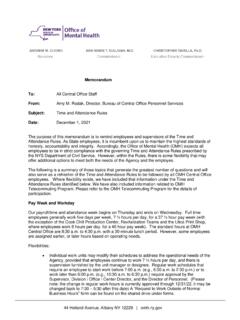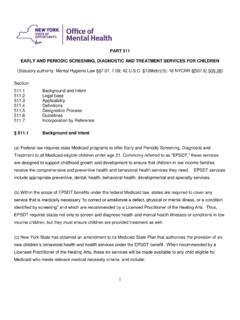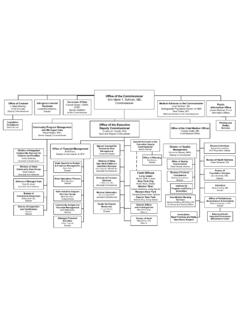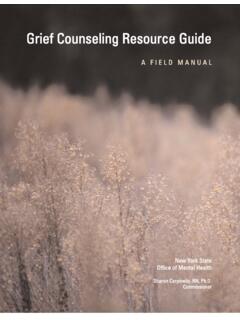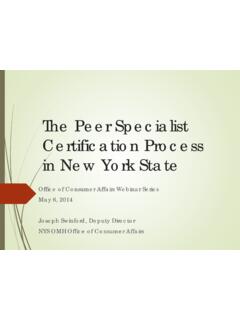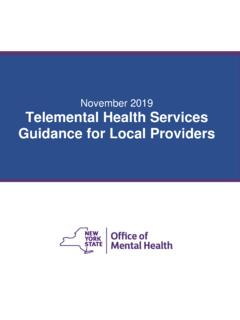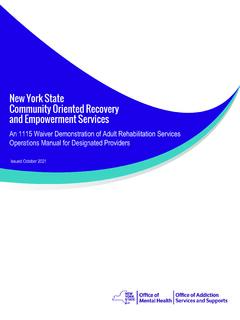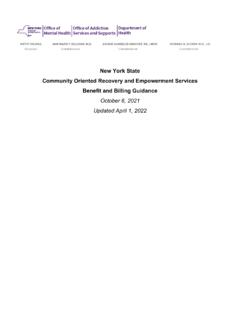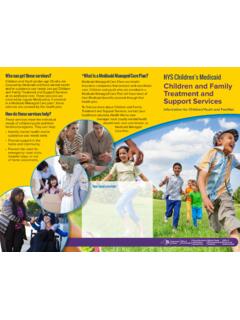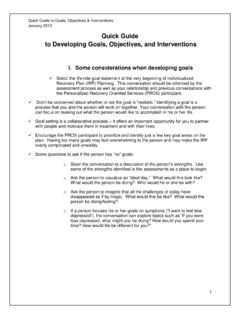Transcription of 2019 Supportive Housing Guidelines
1 Supportive Housing Guidelines 2019 Supportive Housing Guidelines February 2019 1 NEW YORK STATE OFFICE OF MENTAL HEALTH SCATTERED AND SINGLE-SITE Supportive Housing Guidelines 2019 Supportive Housing Guidelines February 2019 2 Contents I. Background .. 3 II. Target 3 The Child and Adult Integrated Reporting System (CAIRS), Additional Reporting Requirements, and Oversight/ Monitoring .. 5 III. Supportive Housing Description .. 6 Resident Participation .. 6 Access to Housing .. 8 Housing Support Services .. 12 Staffing .. 18 Rental-Stipend Requirements .. 18 lease Arrangements .. 21 Facilitating Resident Access to other Housing 21 Home and Community Based Services (HCBS) Settings Rule Compliance .. 23 IV. Cessation of Supportive Housing .. 25 Goal Achievement .. 25 Resident Refusal to pay when Supportive Housing Provider is Landlord .. 26 Resident Refusal to Follow Program Expectations.
2 26 Supportive Housing Provider s Responsibility if Landlord evicts resident .. 26V. Cost Allocation Guidance for Mixed-Use Integrated Housing VI . Conclusion .. 27 Glossary .. 29 Types of Supportive Housing .. 29 Serious Mental 30 Attachment A Resident Rental Stipend Worksheet Attachment A Sample Resident Rental Stipend Worksheet SSI Attachment A Sample Resident Rental Stipend Worksheet Attachment A Sample Resident Rental Stipend Worksheet Eligible Attachment A Sample Resident Rental Stipend Worksheet Public Assistance Only ..44 Supportive Housing Guidelines February 2019 3 SCATTERED AND SINGLE-SITE Supportive Housing Guidelines I. Applicability These Supportive Housing Guidelines apply to the operation of permanent Supportive Housing units funded by the NYS Office of Mental Health (OMH) either through direct contract or through Local Government Unit (LGU) contracts. Supportive Housing settings include scattered-site or single-site developments, specifically including units developed under OMH s Supportive Single Room Occupancy (SP-SRO) initiatives or the Empire State Supportive Housing Initiative (ESSHI).
3 II. Target Populations All individuals served in OMH Supportive Housing must have a primary diagnosis of serious mental illness (SMI). Persons diagnosed with serious mental illness are persons aged 18 and older who have a current mental illness diagnosis as per the DSM-V (or any subsequent edition) and experience substantial impairments in functioning due to the severity of their clinical condition. Specifically, these adults currently experience substantial dysfunction in a number of areas of role performance or are dependent on substantial treatment, rehabilitation, and support services in order to maintain functional capacity. Furthermore, they have experienced substantial impairments in functioning due to mental illness for an extended duration on either a continuous or episodic basis. (See the definition of serious mental illness in the Glossary). Although there are no income requirements for Supportive Housing eligibility, residents generally have low or very low income .
4 Most individuals living in Supportive Housing receive Supplemental Security income (SSI) due to their mental illness. The Housing Provider should Supportive Housing Guidelines February 2019 4 document proof of eligibility at time of admission. This documentation should remain in the resident s file for the duration of their stay. Individuals eligible for admission to Supportive Housing include those being referred from priority settings. These include persons being discharged from State-O perated Psychiatric Centers or state-operated residential programs; persons being discharged from Article 28 psychiatric inpatient hospital care; young adults being discharged from residential Treatment Facilities or Children s Community Residences; residents of OMH-licensed Housing , adult homes, nursing homes, voluntary or municipal homeless shelters or individuals living on the streets; persons with high-cost Medicaid use; the forensic population; and persons under an Assisted Outpatient Treatment order.
5 Additionally, OMH and localities may identify other priority populations and eligibility criteria through Requests for Proposals (RFPs) and/or the Single Point of Access (SPOA) process. Providers are expected to maintain occupancy in Supportive Housing at a 90% occupancy rate. OMH may reallocate units when significant vacancies exist. Please note that there may be additional contractually-based Housing eligibility criteria or requirements depending upon the area of the State or the specific Housing initiative through which the Housing units were awarded. For example, in NYC, the submission and approval of the HRA 2010E Housing application is currently required for most types of OMH-funded Housing . Contracts for Supportive Housing may be directly with OMH (including ESSHI and SP-SROs) or through Local Government Units (LGU s), funded by OMH through State Aid Letter. OMH staff or LGU staff, as applicable, will engage in periodic monitoring of Supportive Housing programs.
6 This may include, but is not limited to: a) a review of tenant records (leases, rent calculations, referrals, etc.); b) program and services review (policies and procedures on services engagement, support plans, etc.); c) property review (inspection of units, maintenance records and practices, etc.); and d) interviews with tenants and residential staff. Supportive Housing providers are expected to Supportive Housing Guidelines February 2019 5 make such records available and make reasonable efforts to allow access to units upon request. Monitoring will typically occur at least once during the term of the contract, or more frequently if corrective action is required. ESSHI projects may involve tenant populations other than individuals with a serious mental illness. Therefore, monitoring for such projects may be conducted collaboratively, involving staff from other ESSHI Interagency Workgroup agencies with expertise and oversight responsibility particular to the population(s) served in the project, and/or monitoring tools developed by those agencies.
7 The Child and Adult Integrated Reporting System (CAIRS), Additional Reporting Requirements, and Oversight/ Monitoring The Office of Mental Health maintains a system that tracks all admissions to and discharges from OMH-licensed and/or OMH-funded, non-licensed funded Housing , including Supportive Housing . Entries to this system are made by the provider at the time the resident is admitted via the Web-based CAIRS application. This system contains information concerning the resident s demographics ( age, race, sex). The Provider is expected to update the system within seven days of either the resident s entry into or leaving Supportive Housing , including the date the resident moves in or leaves as well as the type of residential setting he/she was referred from or is moving into. CAIRS data is used to provide information concerning resident demographics, program performance indicators, program vacancy rates, and other factors that OMH officials, localities, and voluntary a gencies can access to better inform administrative oversight of residential programs.
8 All contracted residential providers, whether through local county contract or direct Supportive Housing Guidelines February 2019 6 state contract, are required to participate in the CAIRS system. Providers are referred to their OMH Field Office for more information concerning this system. III. Supportive Housing Description Supportive Housing is intended to ensure that resident options in choosing preferred long term or permanent Housing are enhanced through: 1. Increasing the availability of safe and affordable Housing options; 2. Ensuring the provision of community supports necessary to assist residents in succeeding in their preferred Housing and to meaningfully integrate them into the community; and 3. Helping residents remain in the Housing of their choice while services change to meet their varying needs. The following section details three areas to guide Providers, and the local mental health system, in fulfilling these goals.
9 These areas are: Resident Participation, Access to Housing , and Housing Support Services. Resident Participation Residents play an integral role in Supportive Housing , including active involvement in the choice of Housing ; type, frequency and intensity of services; and in the exercise of their rights and responsibilities as tenants and individuals. To the extent that options permit (including availability and funding), residents play an active role in the choice of location and living arrangement for their Housing . Services are available to help residents make choices and develop the skills necessary to remain stably housed. Outreach is provided to prospective residents by the Provider to ensure resident awareness of Supportive Housing and encourage resident participation. Providers should establish a formal system (such as satisfaction surveys, resident councils, etc.) to ensure residents have input into development and implementation of agency Supportive Housing practices.
10 Supportive Housing Guidelines February 2019 7 Providers will give explicit written tenant s rights and grievance procedures to tenants upon enrollment in the Supportive Housing program. A copy of these policies, signed by the resident should be maintained in the resident s file. All residents in Supportive Housing should be granted a lease , preferably directly between the tenant and the landlord. If a direct lease is not used, the Provider should enter in a sublease with the tenant. Residents are given opportunities to develop peer to peer supports. Providers will explicitly document tenants receipt and acknowledgement of written rights and grievance procedures upon enrollment in the Supportive Housing program. This verification will include tenant signature, and it is expected that providers will review rights and grievance procedures with tenants quarterly during review of the support plan.
